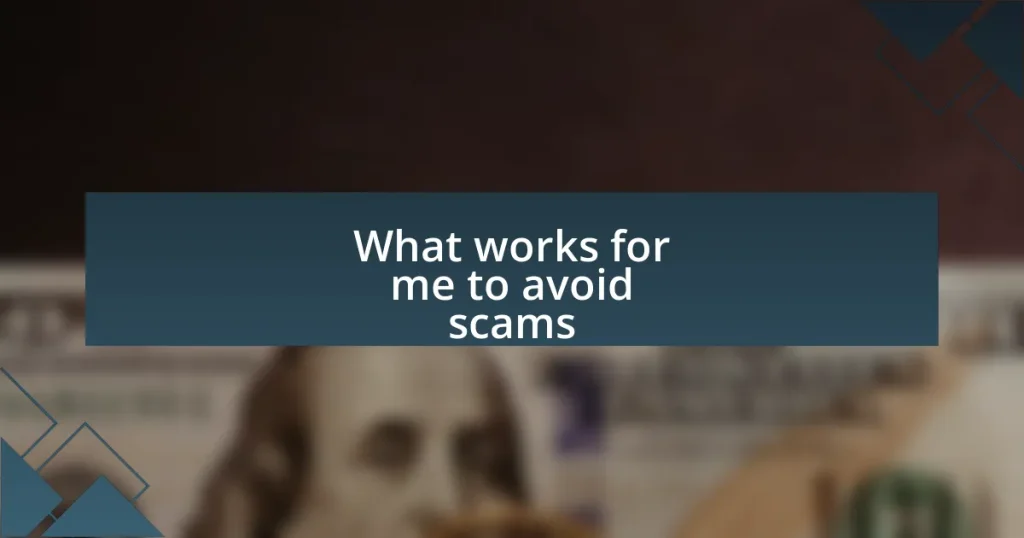Key takeaways:
- Scammers exploit emotions like fear and urgency, often using tactics such as impersonation and phishing.
- Recognizing red flags in offers—such as unexpected fees or requests for personal information—can protect against scams.
- Conducting thorough research on companies and individuals, including checking reviews and verifying contact information, is essential for safety.
- Utilizing technology like two-factor authentication and password managers enhances personal security and protects against breaches.
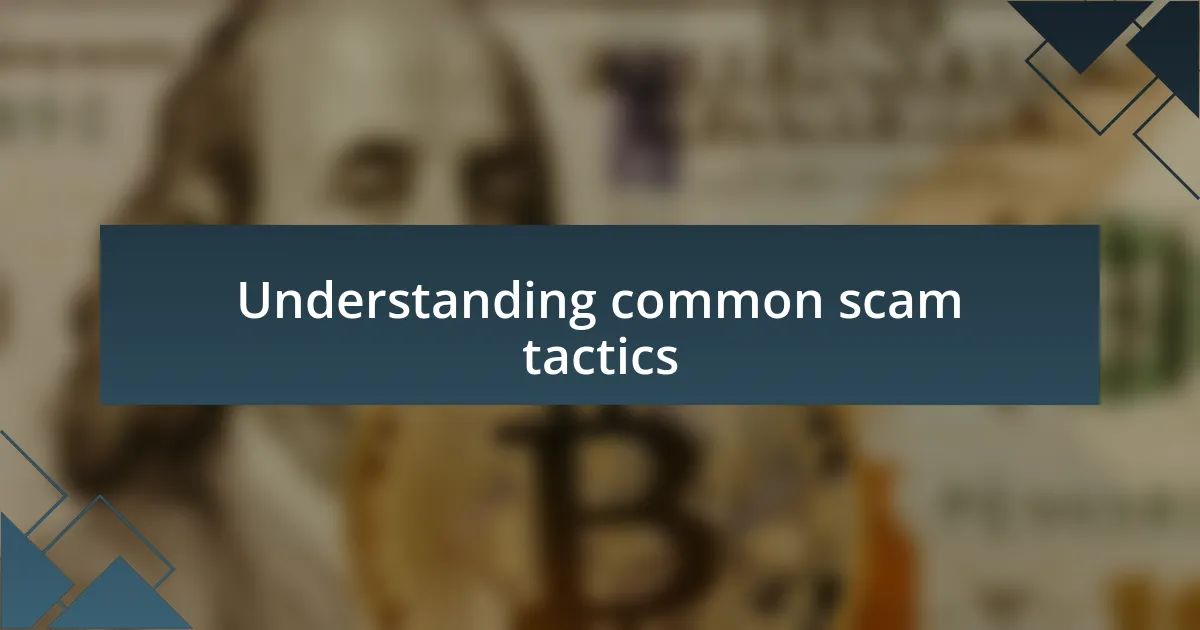
Understanding common scam tactics
Scammers often prey on emotions, playing on fear, urgency, and greed to manipulate their victims. For example, I remember a time when I received an unexpected email that claimed I’d won a free vacation. The rush of excitement almost clouded my judgment, but the moment I noticed the pressure to act quickly, I realized something was off. Have you ever felt that rush, only to pause and wonder if it’s too good to be true?
Another common tactic is impersonation. Scammers can easily forge identities, whether pretending to be a government agency or a trusted friend. I once received a call from someone claiming to be from my bank, asking for my account details. That sinking feeling of doubt crept in as I realized that my bank would never ask for sensitive information over the phone. How many of us just go along with these requests without a second thought?
Lastly, phishing emails are rampant, often cleverly disguised to mimic legitimate sources. There was a time when an official-looking email from what seemed like a reputable company nearly tricked me into clicking a malicious link. It made me wonder—how often do we overlook those small red flags in favor of convenience? Staying vigilant and questioning everything can save us from falling into these traps.
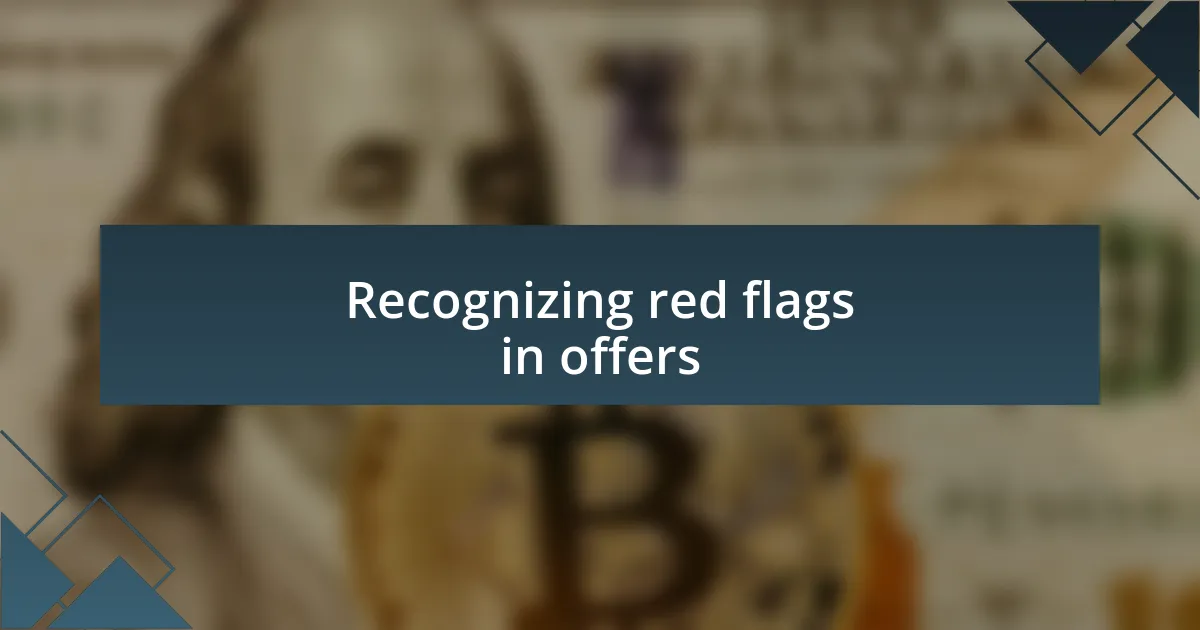
Recognizing red flags in offers
Recognizing red flags in offers is crucial in safeguarding yourself against scams. I can vividly recall a time when I received a message about a secret shopper opportunity that promised hefty pay for minimal work. At first, it seemed like a dream, but several details felt off—like the requirement to pay an upfront fee. That little nagging voice in my head urged me to dig deeper and, thankfully, I did.
Here are some key red flags to look out for:
- Too Good to Be True: If the offer sounds unrealistically lucrative, question its legitimacy.
- Pressure to Act Fast: Scammers often create a false sense of urgency. Legitimate offers will allow you time to think.
- Request for Personal Information: Be wary of any offer that asks for sensitive information upfront.
- Poor Language Quality: Many scam communications are rife with spelling errors or awkward phrasing, which can be a telltale sign.
- Unverified Contact Methods: Check if the contact details are traceable to a reputable company. If not, it’s a red flag.
Trust your instincts; they often signal when something isn’t right. I’ve learned to pause and take a step back when I sense those flags, and that simple act has saved me from potential heartache.
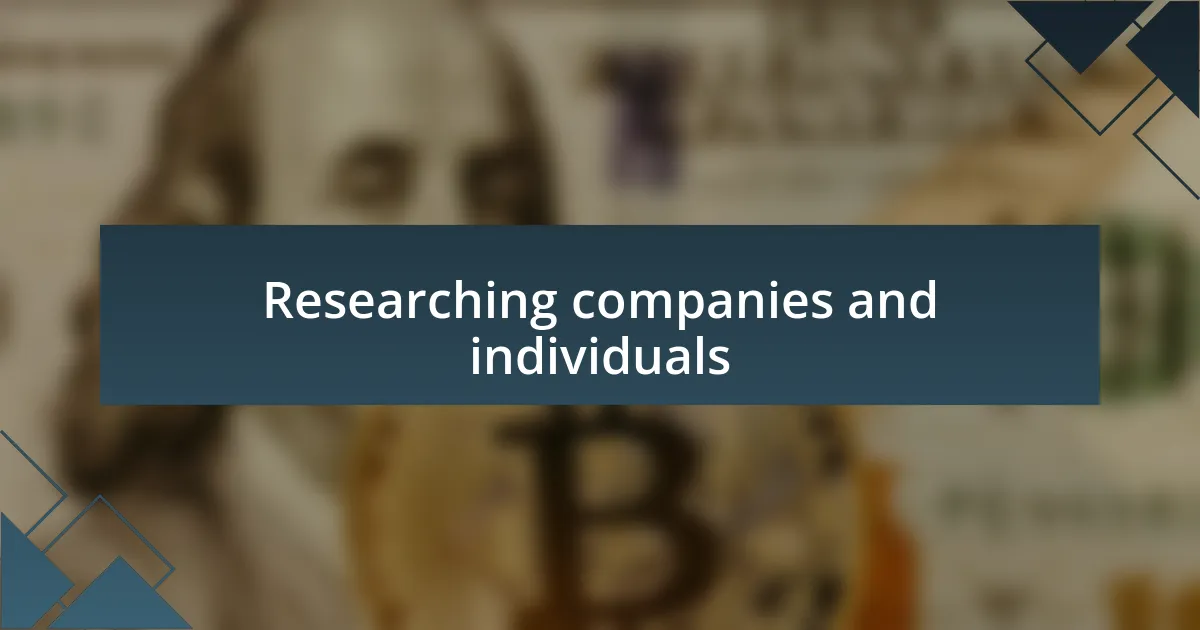
Researching companies and individuals
When it comes to researching companies and individuals, due diligence is my best friend. I remember a time when I looked into a startup claiming to revolutionize online learning. At first glance, their website was sleek and inviting. However, after spending time on platforms like LinkedIn and Glassdoor, I discovered gaps in employee experiences and mixed reviews. Diving into these resources really equipped me to make a more informed decision.
Another valuable tactic is cross-referencing information across multiple sources. I often compare what a company says on its website to what third-party reviews reveal. For instance, a firm I considered partnering with had glowing testimonials on their site, but a quick search on industry forums showcased a different story – complaints about unfulfilled promises. This taught me that authentic insights can often come from those who have walked the path before me.
Lastly, I pay careful attention to the presence of a physical address and customer service channels. It speaks volumes about a company’s legitimacy. A couple of years ago, I encountered a potential contractor whose website lacked basic contact information. This raised a huge red flag for me, and I trusted my gut instinct to walk away. Knowing how to research effectively has saved me from falling prey to scams more times than I can count.
| Research Method | Description |
|---|---|
| Check Reviews | Look up reviews on platforms like Glassdoor or Yelp to gauge reputation. |
| Compare Information | Cross-verify data from the company’s site against third-party sources. |
| Look for Contact Information | A legitimate business typically shares a physical address and reliable customer service options. |
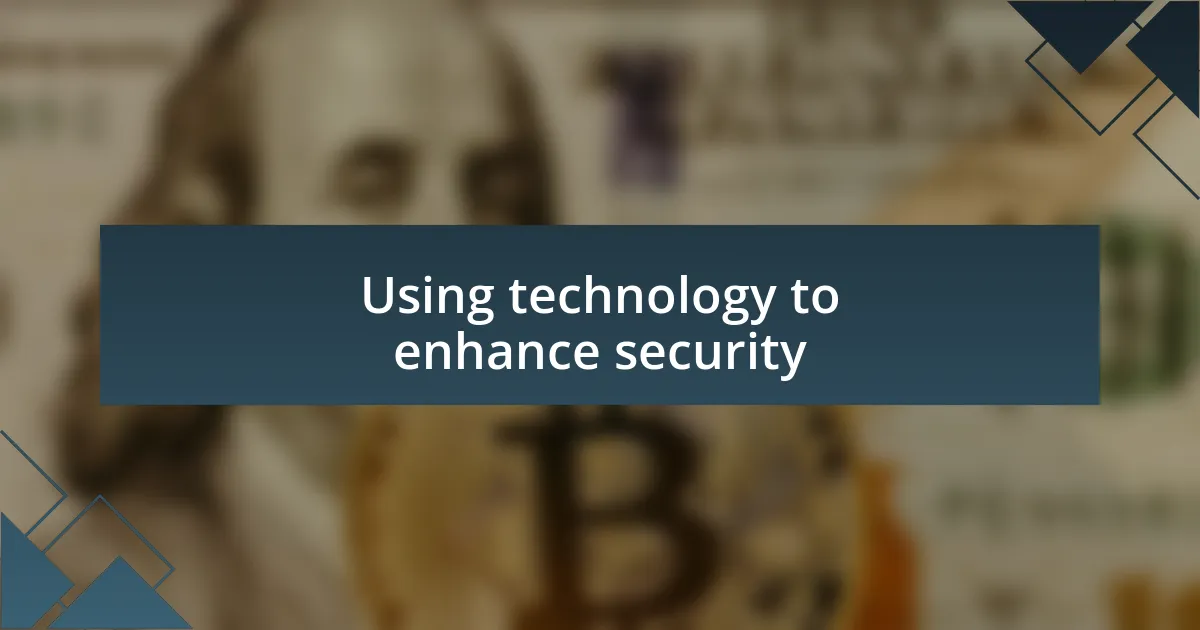
Using technology to enhance security
Using technology wisely has been a game-changer for my personal security. For example, I rely heavily on two-factor authentication (2FA) for my online accounts. When I set up 2FA for my email, I felt a wave of relief knowing that even if someone stole my password, they would still need access to my phone to get in. Doesn’t that just add an extra layer of peace of mind?
Additionally, I’ve found that utilizing password managers has made a huge difference in my digital security. I can create unique, complex passwords for every site without the headache of trying to remember them all. Once, after experiencing a data breach with one of my accounts, I quickly changed all of my passwords with just a few clicks. The thought of widespread exposure brought on an unsettling feeling, but thanks to that technology, I felt more in control of my digital footprint.
Finally, I think keeping up with the latest security software is vital. I usually update my antivirus programs regularly, which helps catch potential threats before they become an issue. I can recall a time when a friend’s computer was compromised due to outdated software, and it was an exhausting mess for them. This realization, combined with the understanding of how accessible this technology is, reminds me that taking a few simple steps can fortify my defenses against scams. How often do you take a moment to assess your online security measures? It might just save you from a potential headache.
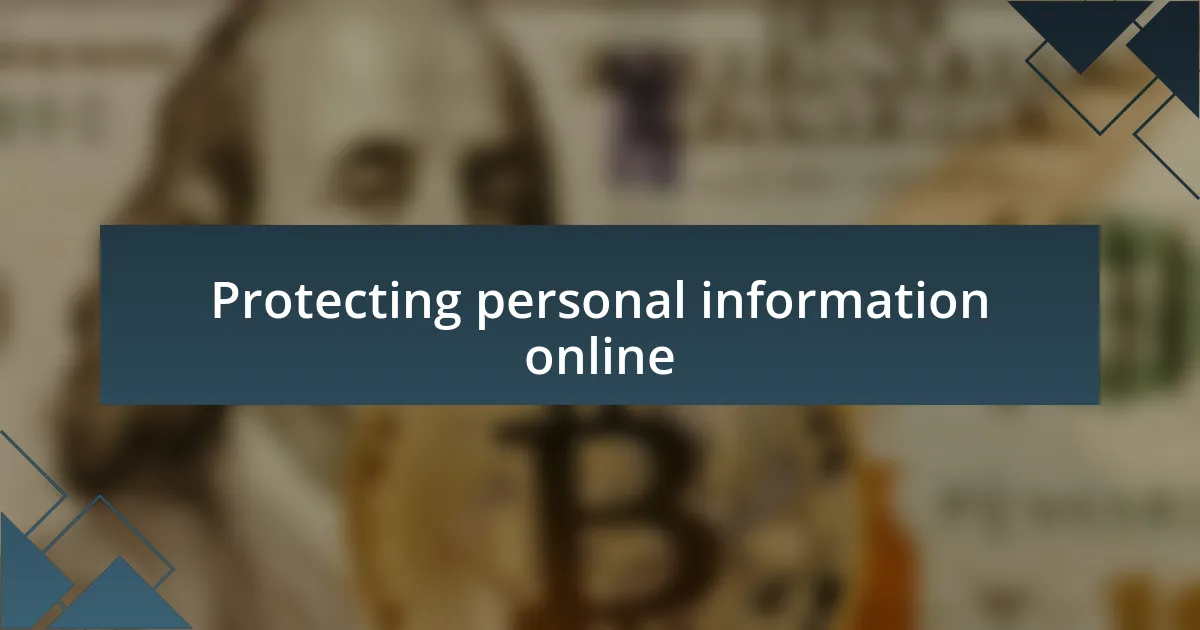
Protecting personal information online
To protect my personal information online, I’ve learned to be extremely cautious about what I share. A few years back, I was tempted to participate in a seemingly innocent survey promising a gift card. I quickly realized that by providing even minor details, like my email address and birthday, I had unknowingly opened the door to potential spam and phishing attempts. Have you ever felt that twinge of disbelief when you look back at your data-sharing decisions?
Moreover, I’ve adopted the habit of scrutinizing website URLs before entering personal information. One time, I almost fell for a URL that mirrored a popular site, but a quick double-check revealed it was a cleverly disguised scam. It’s moments like those that remind me the importance of alertness can’t be overstated. I often ask myself, “Is this site really secure?” Trusting my gut has saved me from many risky situations.
Finally, I regularly adjust my privacy settings on social media platforms. I recall a friend who didn’t realize her posts were viewable to the public until she received unwanted messages from strangers. I believe that taking a few moments to configure these settings can significantly reduce the risk of scams, ensuring your online persona remains protected. What steps do you take to safeguard your personal data? Each measure, no matter how small, contributes to a larger shield against scams.
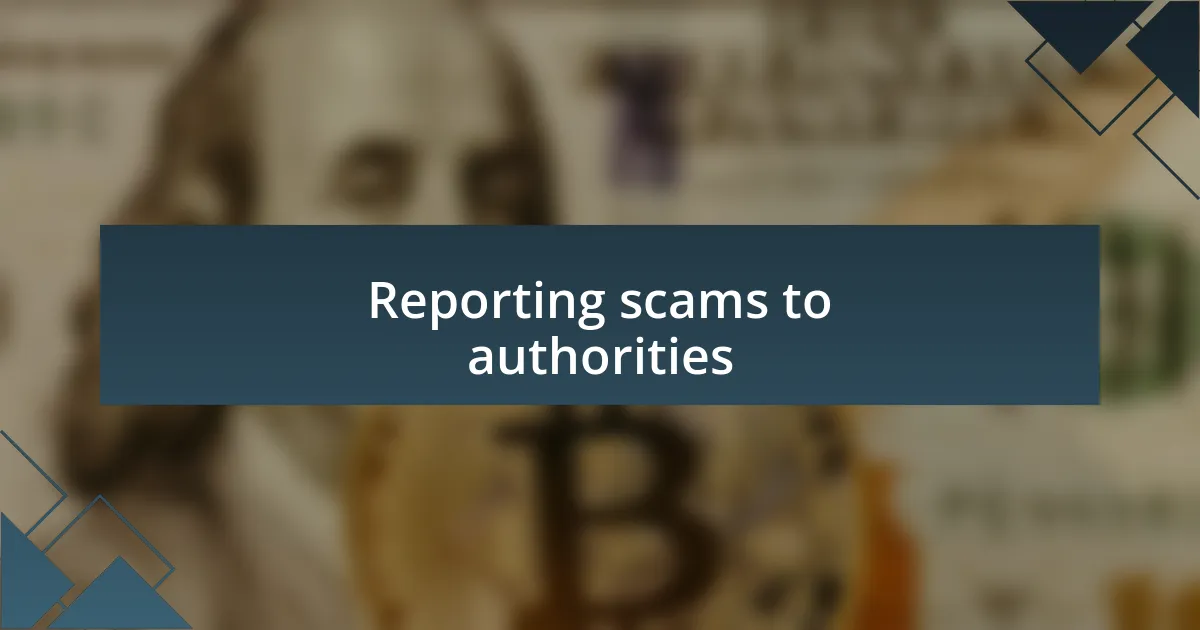
Reporting scams to authorities
Reporting scams to the authorities may seem like a daunting task, but I’ve found it can be incredibly empowering. There was a time when I received a suspicious call claiming to be from my bank, trying to extract personal information. After hanging up, I decided to report it to the local consumer protection agency. I felt relieved knowing I had potentially stopped someone else from falling victim to the same scam.
When I took the time to file a report, I realized how important it is for authorities to gather data on scams. Each report contributes to a larger picture of fraudulent activity, helping to identify patterns and develop better protective measures. Have you ever thought about how your actions can create a ripple effect in the fight against scams? I found that knowing I was part of that effort brought a sense of community and responsibility.
I’ve also learned that different jurisdictions may have various channels for reporting. For instance, I once stumbled upon a scam site and reported it through the Federal Trade Commission’s (FTC) website. It was surprisingly easy, and I knew that I was helping to combat the larger issue of online fraud. Remember, every report matters, and by speaking up, we can collectively fortify our defenses against scammers.











